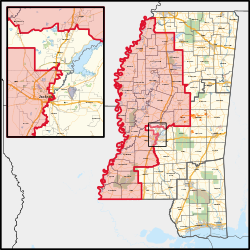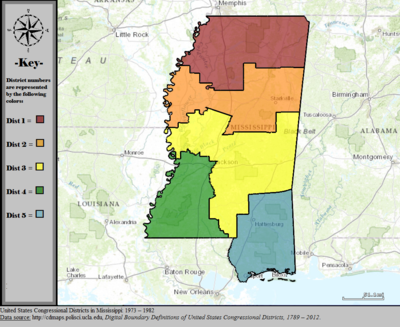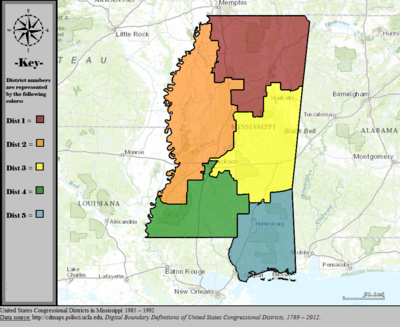
Interactive map version
Mississippi is currently divided into four congressional districts, each represented by a member of the United States House of Representatives. After the 2020 census, the number of Mississippi's seats remained unchanged.

Mississippi is currently divided into four congressional districts, each represented by a member of the United States House of Representatives. After the 2020 census, the number of Mississippi's seats remained unchanged.
This is a list of United States representatives from Mississippi, their terms, their district boundaries, and the district political ratings according to the CPVI. The delegation has a total of four members, including three Republicans and one Democrat.
| Current U.S. representatives from Mississippi | |||||
|---|---|---|---|---|---|
| District | Member (Residence) [1] | Party | Incumbent since | CPVI (2025) [2] | District map |
| 1st |  Trent Kelly (Saltillo) | Republican | June 2, 2015 | R+18 |  |
| 2nd |  Bennie Thompson (Bolton) | Democratic | April 13, 1993 | D+11 |  |
| 3rd |  Michael Guest (Brandon) | Republican | January 3, 2019 | R+14 |  |
| 4th |  Mike Ezell (Pascagoula) | Republican | January 3, 2023 | R+21 |  |
From 1789 to 1817, the Mississippi Territory was represented in Congress by a non-voting delegate. Since becoming a state on December 10, 1817, Mississippi has sent between one and eight representatives to Congress.
| 1817 1 | 1820 | 1830 | 1840 | 1850 | 1860 | 1870 | 1880 | 1890 |
|---|---|---|---|---|---|---|---|---|
| 1 | 1 | 2 | 4 | 5 | 5 | 6 | 7 | 7 |
| 1900 | 1910 | 1920 | 1930 | 1940 | 1950 | 1960 | 1970 | 1980 | 1990 |
|---|---|---|---|---|---|---|---|---|---|
| 8 | 8 | 8 | 7 | 7 | 6 | 5 | 5 | 5 | 5 |
| 2000 | 2010 | 2020 |
|---|---|---|
| 4 | 4 | 4 |
Table of United States congressional district boundary maps in the State of Mississippi, presented chronologically. [3] All redistricting events that took place in Mississippi between 1973 and 2013 are shown.
| Year | Statewide map | Jackson highlight |
|---|---|---|
| 1973–1982 |  |  |
| 1983–1984 |  |  |
| 1985–1992 |  |  |
| 1993–2002 |  |  |
| 2003–2013 |  |  |
| 2013–2023 |  |  |
| 2023–present |  |
Mississippi's at-large congressional district existed from the granting of statehood in 1817 to 1847 and again from 1853 to 1855.
The fifth congressional district was created after the 1850 census and abolished following the 2000 census.
The sixth congressional district was created after the 1870 census and abolished following the 1960 census.
The seventh congressional district was created after the 1880 census and abolished following the 1950 census.
The eighth congressional district was created after the 1900 census and abolished following the 1930 census.